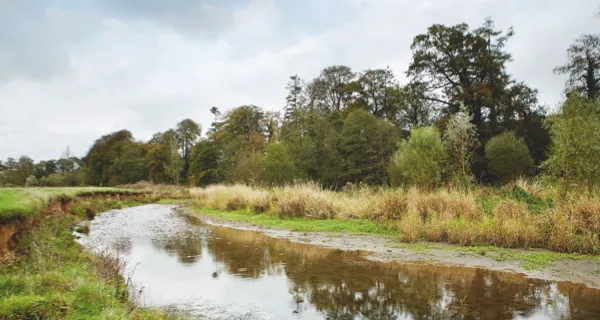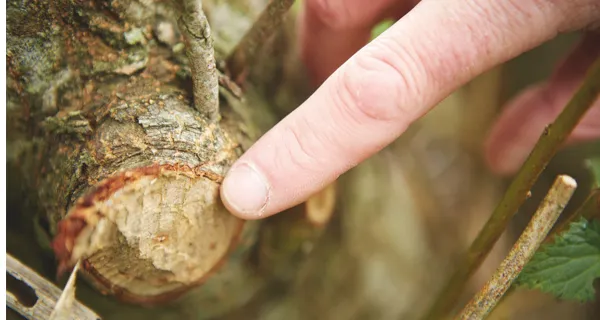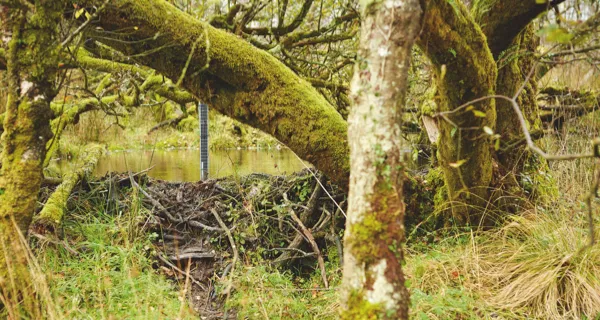"Size of a Labrador – well, at least a cocker spaniel,” says Peter Burgess, conservation manager for Devon Wildlife Trust.
We are standing beside the River Otter in Devon talking about the Eurasian beavers that have set up home here and I am quickly revising – upwards – my idea of how big these creatures are. Having been bombarded with opinions for and against the continued existence of this wild population, I’m determined to see for myself what impact beavers are having on the landscape.
Beavers were once native to the UK but were hunted to extinction as recently as 300 years ago – “as vermin, for their fur and also for their meat, which was highly prized,” says Peter. Now, 10-15 human generations later – “only a blink of an eye in ecological terms” adds Peter they have returned and there are perhaps 10 on the Otter. No one knows how they got here, although escapes from private collections have occured elsewhere in the UK. Others claim the beavers were released deliberately.
Arguments rage as to whether the animals should stay. Conservationists such as DWT say that beaver dams improve a river’s water quality and flow, as well as creating mosaics of habitat for a range of wildlife; some anglers fear the dams will impede migrating fish, while some landowners and riverside homeowners are concerned about potential flooding caused by the dams as well as loss of trees and crops.
Defra wishes to capture the beavers to test them for a disease that is potentially fatal to humans: Echinococcus multilocularis. This is welcomed by the Angling Trust and landowning organisations such as the CLA. The DWT agrees that they need to be tested but is concerned the beavers would not be released back into the wild if proved to be disease-free.

A stretch of the River Otter in Devon
Photo credit: Oliver Edwards, FLPA
I wanted to get a feel for the impact they are having on the River Otter. Peter and his colleagues are monitoring the wild population and he leads me from a public footpath into a willow and alder thicket beside the river.
Soon we are in a wilderness of waterlogged woods, oxbow lakes and side streams – the result of the river’s sporadic, meandering force taking advantage of the area’s friable soils. A kingfisher zeeps past, a young heron takes off wearily with an audible “harrumph” and siskins chatter from the alders.
Where are the dams, I ask? “Well, the water is deep enough for them here not to need them. The beavers use dams to create deep pools as refuges, as well as to make it easier to get around. They also use deep water as a refrigerator to store food in over the winter. So they tend to build the dams in the smaller upper tributaries,” says Peter.

This wood rush shows tell-tale signs of beaver nibbling
Photo credit: Oliver Edwards, FLPA

as does this willow twig
Photo credit: Oliver Edwards, FLPA
We had to search quite hard to find signs of the animals’ impact – the ends of willow twigs and branches, chiseled to a fine, pencil point and occasional felled saplings. Eventually, and to my delight, we found a newly felled willow tree.
Its trunk was a foot in diameter, chiseled through in cartoon-fashion and surrounded by bright wood chips. “How long would a beaver take to get through this?” I ask. “One evening,” Peter replies. I won’t be able to give up my chainsaw just yet.

Fergus and Peter inspect a newly felled adult willow
Photo credit: Oliver Edwards, FLPA
Alas, that is the most we see of the beavers in the wild – they’re mostly active from dusk to dawn. But surely the impact on the landscape would increase were the population to grow and spread through the river system?
“That’s why we’ve been running a captive beaver project since 2011, so we can monitor them over many years,” says Peter. He drives me to the little-known heart of Devon some 50 miles from the River Otter – an area of rare ‘culm’ grasslands.
Here the DWT has built an impregnable fence around a soggy area of scrubby wood and introduced a pair of beavers, which have raised three young. The idea is to see whether these captive beavers will control the scrub through their felling and dam-building and if there is an additional impact on biodiversity.
We take great care going through the electric fence – and beyond that, the impact of the beavers is startling. Throughout this wet woodland with its trickle of water, the beavers have built dams, creating glades and a series of stepped pools, which Peter decribes as “paddyfields”.
Between these, the beavers have built a network of canals to help them move around. Peter tells me that “they’re triggered by the sound of running water, which helps them patch up holes in their dams”.

Built from mud and woven sticks, this dam at the captive project is 1m high
Photo credit: Oliver Edwards, FLPA
The dams themselves are impressive – up to one-metre high – and, though there are no fish in this boggy wood, such a structure would surely impede a stream. Mark Lloyd of the Angling Trust told BBC Countryfile Magazine earlier this year: “Nearly all fish need to move up and down rivers and the addition of beaver dams to the 20,000 man-made weirs and dams already on our rivers and would only increase the number of obstacles that fish have to overcome.”
I put this to Peter. He acknowledges that beavers could be a localised problem for fish in tributaries, but he offers a solution. “In places where it’s unacceptable, dams could be removed or access restricted to vitally important fish-spawning areas.
The same could be done if the beavers damaged orchard trees or favoured crops such as sugar beet and carrots. As a last resort, the beavers could be relocated.”
Peter also accepts that beaver activity might prompt more vegetation flowing downstream, which could block culverts and cause localised flooding. Again he says this could be managed.
“But who’s going to do all this management?” I ask.
“Us.”
“Who’s going to pay?”
“Us.”
“You must really believe in them!”
“Beavers are a keystone species whose actions offer multiple benefits,” he replies. “A study by Scottish Natural Heritage shows that beavers’ pools (with plenty of woody material in them) act as refuges for vulnerable fish fry and generally improve a river’s fish stocks.
"Beavers’ felling activity also opens up banksides, letting light and life into rivers and that’s not just good for fish – butterflies, dragonflies and a host of creatures love riverside coppice woodland and meadow. Before the beavers, we would have about four clumps of frogspawn [in the captive project area]. We had 370 this year.”

Perfect beaver habitat: an oxbow on the River Otter
Photo credit: Oliver Edwards, FLPA
Peter shows me how the DWT has put in sophisticated equipment to measure water and pollution flows in and out of the ‘test area’. It demonstrates how the beavers’ actions are keeping water in the woody meadows for far longer than in the surrounding pastoral and arable fields.
“We’ve shown that this creates a steady year-round flow – with the potential to keep flash flooding to a minimum,” says Peter. “The dams also act as settling tanks and filter systems, removing pollution from the water. Several water companies have shown interest in how this works. It’s a far cheaper solution than trying to sort the problem downstream.”
It all sounds good but I am reminded of Mark Lloyd’s point that the beavers were introduced illegally: “there was no democratic decision taken with proper consultation with local people, businesses and landowners to seek their views.”
“We don’t know who was responsible for the wild beavers but we’re now holding regular public meetings with local people and landlords,” Peter replies. “The landowners are cautious, waiting to see what happens on the Otter – and one or two can see the potential for beaver watching ecotourism. Other locals are almost wholly in support. Of the 230 responses, 225 are in support. The public consultation is still open.”
Whatever happens, it’s sure to be a slow process. Defra is still keen to trap the wild beavers, test them for disease and, at time of going to press, was considering DWT’s application for the beavers to be returned to the wild. Even if Defra says yes, the DWT will have its work cut out convincing angling bodies that now is a good time to embrace the beaver. [Note: since this article was written, the beavers have been trapped, found to be free of disease and so were released back into the wild].
In the meantime, the DWT will continue its project in the culm grasslands – and look for a wider water catchment in which to test the efficacy of the beaver.
Most curious of all, Peter pointed me to a recent article by beaver expert Derek Gow, which more than hinted that there are other beavers at large in England. And on the River Tay in Scotland, 200 beavers are living wild. Has the beaver dam already burst?

